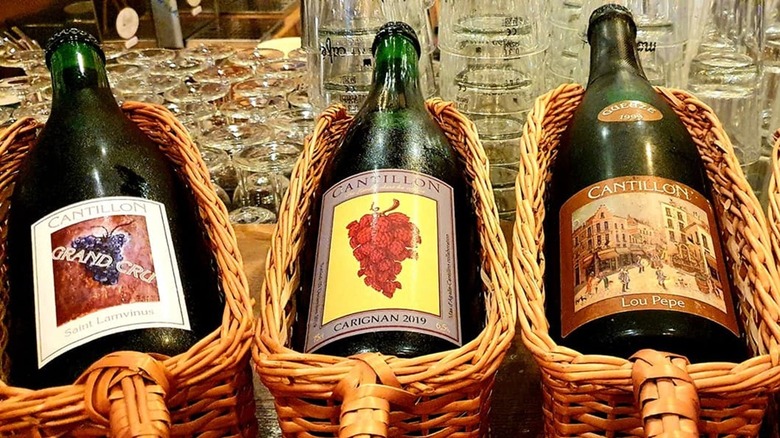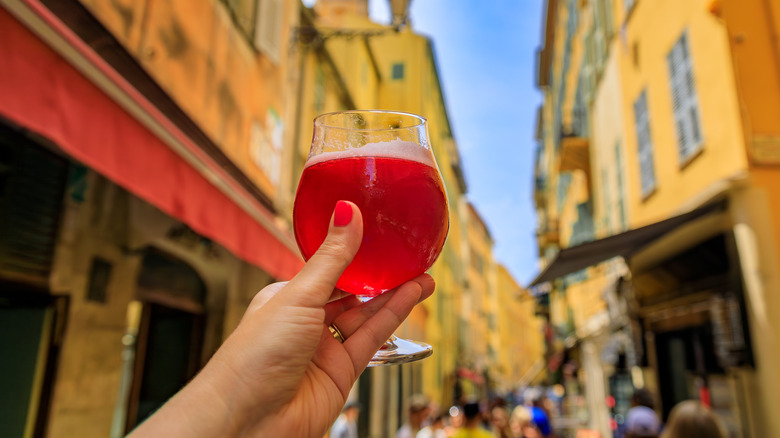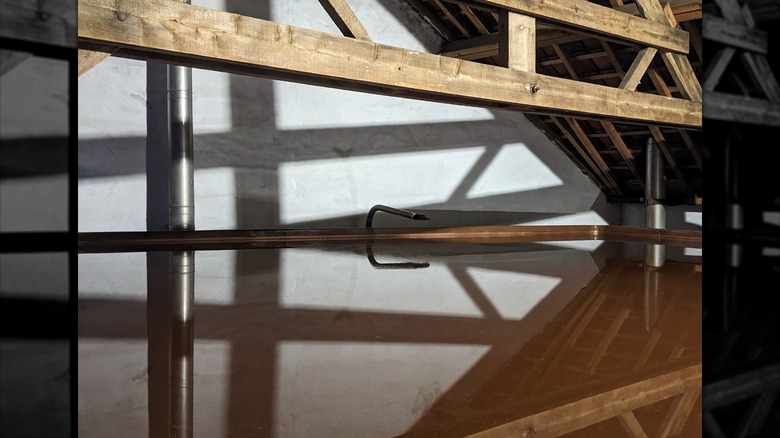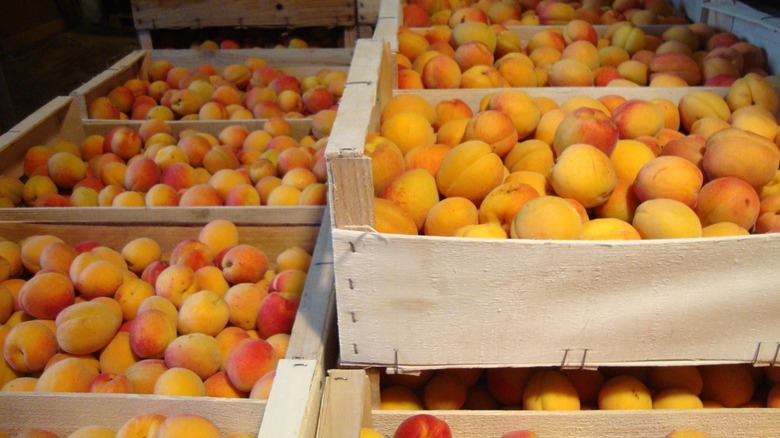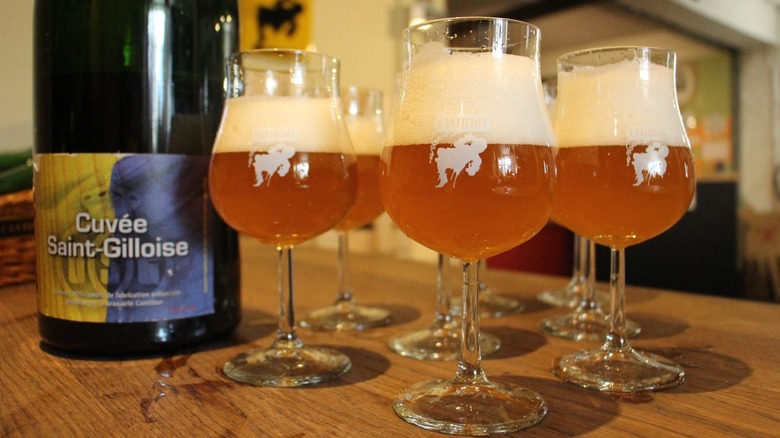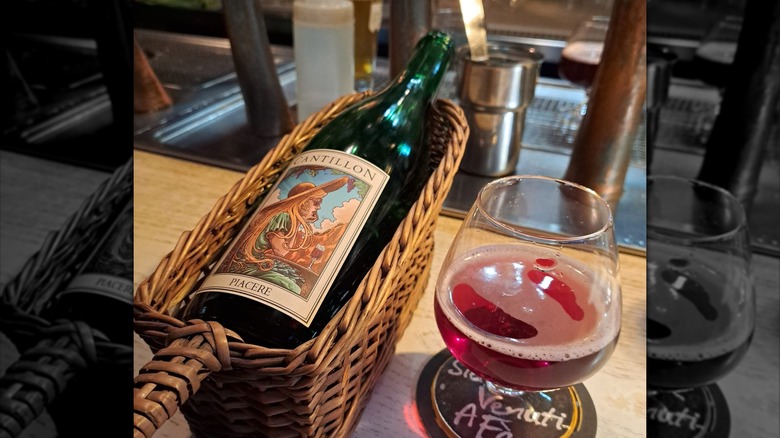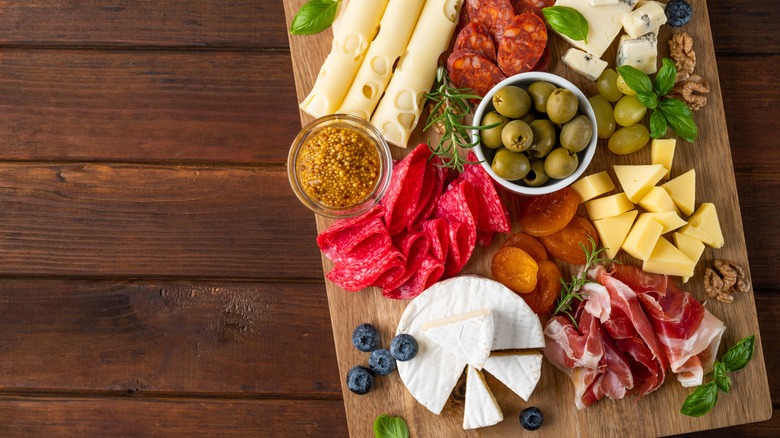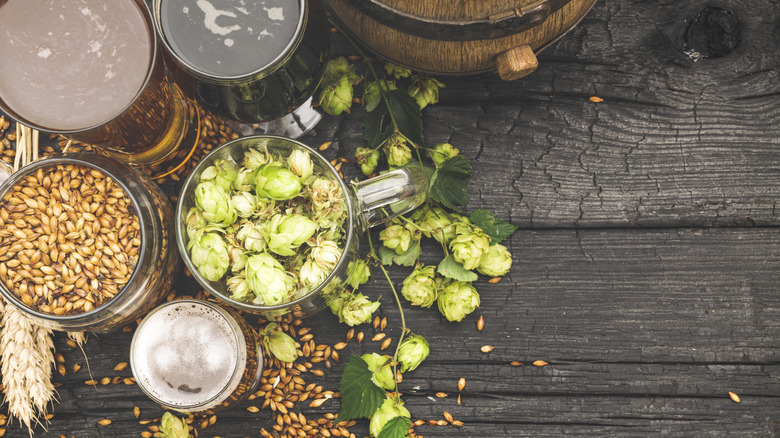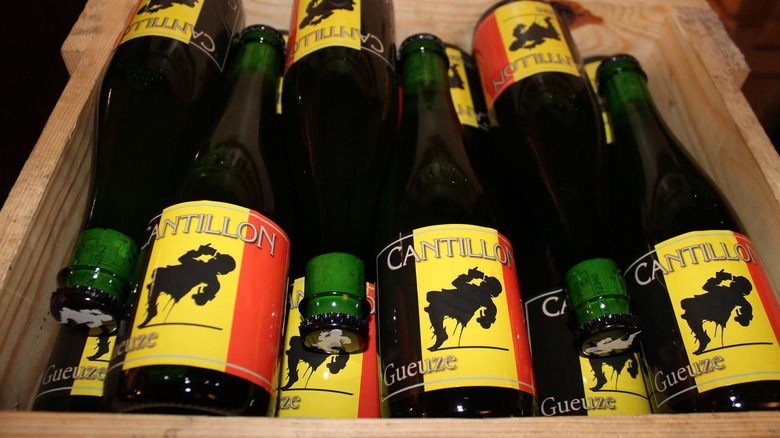Experts Guide To Cantillon: One Of The Hardest Beers To Find In The US
Funky, fermented, and wildly complex; lambic beers are a flavor experience like no other. Lambic beer comes from Belgium and is exclusively produced in the Payottenland area just outside Brussels. The technique used to brew lambic dates back to the medieval period, when beer was made using natural processes and before modern understandings about yeast cultivation and mechanized brewing were commonplace. Located just outside Brussels city center, Brasserie Cantillon is one of the oldest remaining lambic breweries in the region and has a formidable reputation in the craft beer world.
The brewery was founded in 1900 by Paul Cantillon and is still family-owned. Today, it is run by fourth-generation brewer Jean-Pierre Van Roy and produces a small selection of beers, including blended lambic — known as gueuze — and various fruit lambics. Similar to other fermented foods, such as kimchi or sauerkraut — interestingly, a secret ingredient that can keep your chocolate cake moist — Cantillon beer is well-known for its intense sour flavor. While some Cantillon products can be shipped to the U.S., finding lambic outside Belgium can be challenging.
Master Beer Judge for the Beer Judge Certification Program (BJCP), Geoff Bragg is an expert in beer tasting and has first-hand experience sampling Cantillon lambic, which he describes as a "funky, barnyard rollercoaster of flavors." Fascinated by this description, we just had to learn more, so we spoke with Geoff about Brasserie Cantillon to discover the secrets of this mysterious Belgian beer.
What is lambic beer?
According to Geoff Bragg, "a lambic beer is an uncarbonated wild ale that is spontaneously fermented." Brewers start with around 35% unmalted wheat and around 65% malted barley, to make lambic. These ingredients are mulched together to form a mash, which is then boiled in a large container to extract sugars from the grain and create a sweet liquid brew or wort. The wort is transferred into large, shallow vats, known as coolships, which used to be more commonplace in breweries before the arrival of modern brewing techniques.
Usually located in the brewery's attics or rafters, coolships allow the lambic to cool and start the spontaneous fermentation process. Like most lambic breweries, Brasserie Cantillon has vents around its coolships, which let the outside air circulate and mingle with the beer. Wild yeasts and bacteria from the local environment cause the brew to naturally ferment, turning the sugar into alcohol and beginning the wort's transformation into lambic. The beer is then left to age for 1-3 years in wooden barrels.
Bragg explains that lambic blends are also common. For instance, gueuze "is a blend of 1-2 and 3-year-old lambics that is refermented in a corked and caged bottle for natural carbonation, much like Champagne." Brewers in the region also make fruit-flavored lambics by steeping cherries, apricots, berries, or peaches in the lambic barrels as the beer ages.
The lambic brewing process is uniquely delicate
Unlike modern beers, lambic can only be produced during the winter months, usually from October to April, as the wort needs to rest at temperatures between -8 and 8 degrees Celsius to fully chill in the coolships. Local brewers refer to lambic that has overheated and spoiled as bezomerd, meaning it has had too much exposure to active microflora that flourish in a warm environment. Similar to how you can tell when yogurt has gone bad, spoiled lambic will have an overly sour or vinegary flavor. Geoff Braggs explains that climate change is significantly impacting lambic production, as shorter winters mean there are fewer days when the temperature falls within the correct limits for naturally cooling lambic.
Cantillon and other lambic producers also add aged hops to their brews instead of the fresh ones used in other beer styles. Hops are antimicrobial, which helps preserve beer, but have a strong bitter flavor. Aged hops still provide this antimicrobial protection but lose their bitterness, introducing musty and cheesy notes to the lambic's flavor and balancing its sharpness. Like other breweries in the region, Brasserie Cantillon uses these traditional brewing techniques unique to lambic. However, Bragg observes that, when it comes to reputation and quality, "Cantillon is the quintessential lambic beer that all other sour beers are judged against," mainly because of the brewery's historic legacy and its longstanding commitment to creating authentic lambics in the traditional style.
Varieties of Cantillon beer
As well as straight lambic and gueuze, Brasserie Cantillon also produces a small supply of fruit beers and floral beers that can be tried at the brewery. Geoff Bragg explains that a "typical fruit gueuze is made with cherries, peaches, or raspberries but may include honeysuckle, grapes or whatever their heart desires." Cantillon makes various cherry gueuze blends or kriek (cherry lambic) and a Framboise Lou Pepe — raspberry lambic — that's flavored by steeping fresh berries in 2-year-old beer. Cantillon's Fou'Foune is an apricot gueuze with beautiful copper coloring, while rhubarb gueuze is mouthwateringly tart.
Cantillon also produces Mamouche — an elderflower lambic — and a range of lambics and gueuze aged with wine grapes, like merlot or viognier. This creates complex blended strains that walk the line between a beer and a wine. If you enjoy a hoppy flavor in your beer, Cantillon also makes Cuvée Saint-Gilloise — a 2-year-old lambic with fresh hops added. You can also try Cantillon faro – a sweetened, low-alcohol style of lambic which is available locally in Brussels.
Where can you buy Cantillon beer?
If you're wondering why you've never seen Cantillon lambic on the grocery store shelves, Geoff Bragg explains that "Cantillon is difficult to find and expensive in the United States." Brasserie Cantillon is a small producer, meaning it only exports a limited supply of bottles each year. The brewery even introduces restrictions on certain products so that customers can only buy a few bottles at a time.
Some specialty Belgian retailers, like BelgiumMart, Lime Ventures Inc., and The Cellar Bottle Shop, sell Cantillon beers online, where you can expect to pay anywhere between $27 and $40 for a bottle. However, stock availability is ultimately based on the Brasserie's output and bottles can sell out quickly. You can also find Cantillon served at Monk's Café – an authentic Belgian bar in Philadelphia.
If you want to taste Cantillon beer in its natural setting, Bragg notes that lambic "can be more easily found in Belgium and is significantly less expensive at the source." You'll find lambic, gueuze, and fruit lambics served at bars throughout Belgium and Germany and at numerous Brussels restaurants. You can also sample Cantillon in the Brasserie if you go for a museum and brewery tour.
What does Cantillon beer taste like?
Like other aged alcohols, such as wine, whisky, or fernet — an aromatic herbal liqueur that's a bartender's best friend when mixing cocktails — lambic has a deep and complex flavor profile. Geoff Bragg states, "the immediate flavor that stands out in Cantillon and other lambics is the sourness." In straight lambic, this sour flavor comes from the bacteria and yeast, while fruit lambics have an additional tartness that stems from the produce aged inside the barrel.
Beyond this sourness, Cantillon lambic and gueuze have a ripe, pungent taste rich with earthy notes, like "wet leather, goat, and horse blanket." Some lambics contain nutty overtones or remind drinkers of sour yogurt or dairy. If this doesn't sound very appealing, it's important to remember that lambic is an acquired taste that can take a while to get used to. As every bottle is unique, depending on its blend, fermentation time, and the changes it undergoes when opened and exposed to the air, the flavor variations are almost endless.
How to cook with Cantillon beer?
While cooking with beer is quite common — think beer-battered fish or steak and ale pie — lambic is best sipped with an accompanying snack. When asked what to pair with Cantillon lambic, Geoff Bragg observes that these beers "carry a fair amount of acidity and, therefore, tend to hold up well with rich or fatty foods." Bragg adds that Cantillon lambics are perfect to drink alongside a charcuterie platter loaded with cheeses, cured meats, and fatty snacks like olives, nuts, and spreads.
Lambic beers pair especially well with creamy washed rind and blue cheeses, which undergo a similar natural aging process and have rich, complex flavors. These types of cheese elevate your charcuterie board alongside fatty meats like Italian mortadella or liver pâté. Adding chutneys or fresh fruits to your platter can enhance your lambic's sour, tangy notes by contrasting them with sweetness. You could also pair a square of dark chocolate with your beer to help draw out its earthy notes and provide some bitterness.
Nutritional and ABV information about Cantillon beer
Like other types of beer, the calories in Cantillon lambic come from carbs and alcohol. Sugar in the beer is broken down into alcohol during fermentation, meanwhile, leftover sugars contribute calories from carbs. Unsweetened lambic contains no added sugar and very little residual sugar. Lambic also contains tannins, which are present in both hops and barley, giving the beer a dry, astringent mouthfeel — the same role tannins play in wine.
Cantillon lambics are around the same strength or slightly stronger than regular beers. Cantillon's straight lambic, Grand Cru Bruocsella, is a 5% ABV beer. Meanwhile, the Brasserie's gueuze and kriek are 5.5% ABV. The strongest Cantillon lambics — Drogone Lambic and Saint Lamvinus — come in at 7% ABV. Gueuze also contains very little sugar as the young lambic is refermented when blended with an older lambic, causing almost all the sugar to break down.
However, the standard amounts of sugar and alcohol in Cantillon lambics can be difficult to determine. As Geoff Bragg explains, "every lambic bottle ends up unique depending on the brewing day and the day of consumption."
How to store Cantillon beer
When it comes to whether beer lasts longer in cans or bottles, usually the cans have it. However, Cantillon and lambic beers are almost always sold in bottles — although you will occasionally find bagged lambic in Belgium. Storing your Cantillon sideways, like a bottle of wine, helps the beer moisten the cork, which stops it from drying out and letting in air.
It is also important to store your Cantillon in a dark room as beers can be affected by bright light, which can cause them to lose their flavor. Cantillon is usually sold in brown or green glass bottles to help protect against this. To further preserve your lambic, store it in a cool place with a temperature between 10-13 degrees Celsius. Temperature fluctuations can also cause the cork to change shape, allowing air into your lambic, which creates oxidation and dilutes the flavors. You should also avoid disturbing the bottle too much, as this can cause yeast sediment to float into the beer.
You can keep an unopened bottle of lambic for a long time – 20 years or more in some cases. In fact, the aging process adds to the flavor of the beer. As Geoff Bragg explains, the whole process of making lambic, from brewing to drinking takes time. "There is no way to rush this beer," he observes, "the brewer creates the wort — everything else is up to Mother Nature."
